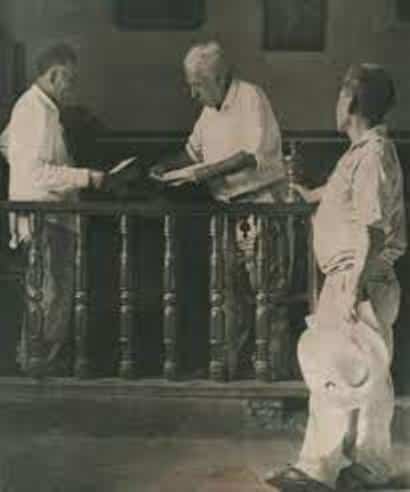Robert J. Weitlaner, also known as R.G. Weitlaner, was an Austrian-American anthropologist and ethnobotanist who conducted research on Salvia divinorum in the mid-20th century. Weitlaner’s work on Salvia divinorum is considered pioneering and has contributed significantly to the understanding of the plant’s traditional use among the Mazatec people of Mexico.
Weitlaner conducted field research in Mexico during the 1950s, where he first encountered Salvia divinorum and learned about its traditional use by the Mazatec people. He collected botanical specimens of the plant and documented its cultural significance, as well as the rituals and beliefs associated with its use. Weitlaner’s research was published in various scientific journals, including the American Anthropologist and the Bulletin of the New York Botanical Garden.

Weitlaner’s work shed light on the Mazatec people’s ritualistic use of Salvia divinorum, including its role as a sacrament in divination, healing, and spiritual ceremonies. He documented the Mazatec people’s beliefs about the plant’s effects, its preparation, and its cultural significance. Weitlaner’s research played a crucial role in bringing attention to Salvia divinorum as a unique and sacred plant used in Mazatec traditional practices.
In addition to his research on Salvia divinorum, Weitlaner also made significant contributions to the fields of ethnobotany and anthropology. He conducted extensive research on the indigenous peoples of Mexico, including the Mazatec, Mixe, and Mixtec peoples, documenting their traditional knowledge, practices, and belief systems. He also contributed to the understanding of pre-Columbian archaeology in Mexico and the history of indigenous cultures in the region.
Weitlaner’s work on Salvia divinorum and other indigenous plants of Mexico has helped raise awareness about the cultural significance of these plants and the need for their preservation. His research has been referenced by subsequent scholars and researchers in the field of ethnobotany, and his contributions to the understanding of Salvia divinorum’s traditional use among the Mazatec people have been invaluable.
It’s worth noting that Weitlaner’s research on Salvia divinorum and other indigenous plants was conducted during a different era, and the ethical considerations and cultural appreciation that are emphasized in modern ethnobotanical research were not as prevalent at the time. However, Weitlaner’s work laid the foundation for further research on Salvia divinorum and its traditional use, and his contributions continue to be recognized in the field of ethnobotany.
In recent years, there has been a growing awareness of the importance of cultural appreciation, respect for indigenous knowledge and practices, and ethical considerations in ethnobotanical research. Scholars and researchers in the field of ethnobotany are now placing increased emphasis on engaging with indigenous communities, obtaining informed consent, and acknowledging the cultural significance of traditional plant use.
Was Robert J. Weitlaner The First Westerner To Discover Salvia Divinorum?
No, Robert Weitlaner was not the first Westerner to discover Salvia divinorum. The plant was first documented by Jean Bassett Johnson, an ethnobotanist and anthropologist, in the 1930s.
Jean Bassett Johnson conducted field research in Mexico and documented the use of Salvia divinorum among the Mazatec people in his work published in the Botanical Museum Leaflets of Harvard University in 1939. She collected specimens of the plant and described its traditional use in divination and healing ceremonies among the Mazatec people.
Robert Weitlaner, on the other hand, conducted his research on Salvia divinorum in the 1950s, after the plant had already been discovered and documented by Jean Bassett Johnson. Weitlaner’s research focused on further documenting and describing the Mazatec people’s use of Salvia divinorum, including its preparation, use, and cultural significance. His work was published in various articles and papers in the 1950s, providing valuable insights into the traditional use of Salvia divinorum among the Mazatec people.
While Weitlaner’s research made significant contributions to the understanding of Salvia divinorum, he was not the first Westerner to discover the plant. That credit goes to Jean Bassett Johnson, whose earlier work laid the foundation for subsequent research on Salvia divinorum.
Sources:
- Weitlaner, R. G. (1957). Notes on the Use of Ska María Pastora (Salvia divinorum Epling and Játiva-M.) in Divinatory and Healing Ceremonies. Botanical Museum Leaflets, Harvard University, 18(3): 33-69.
- Weitlaner, R. G. (1963). Salvia Divinorum: An Ethnographic Study. Economic Botany, 17(2): 158-161.
- Wasson, R. G. (1962). Notes on the Present Status of Ololiuqui and the Other Hallucinogens of Mexico. Botanical Museum Leaflets, Harvard University, 20(5): 65-108.
- Valdés, L. J., & Díaz, J. L. (2012). Ethnopharmacology of Ska María Pastora (Salvia divinorum): A Mexican Entheogenic Mint. In Ethnopharmacology of Medicinal Plants: Asia and the Pacific (pp. 345-364). Springer.
- Valdés III, L. J., Butler, W. M., & Hatfield, G. M. (1987). The Mazatec Psychoactive Herb: Salvia divinorum, New Genus and Species of the Labiatae from Oaxaca. Journal of Ethnopharmacology, 12(3): 305-310.
- José-Luis Díaz (1975). Salvia divinorum: A Psychopharmacological Riddle and a Mind-Body Prospect



